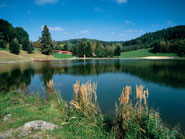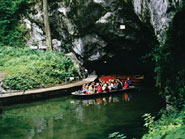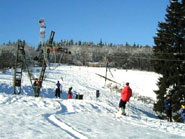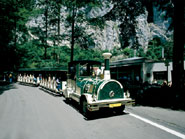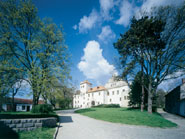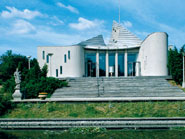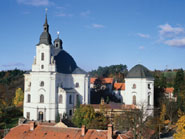HOLIDAYS IN THE BLANSKO REGION
Welcome to the Blansko region ...
... to a tourist locality offering a unique combination of historical,
cultural and technical monuments and a great many areas of natural interest. Get
to know the individual character of the most important karst area in Central
Europe and experience seven fairytale days of vacation ...
Day 1: Blansko - "History and Recreation"
We would like to invite you to visit the natural centre of the
region - the town of Blansko, which is often called the gateway to the Moravian
Karst. You can begin your wander around the town by admiring the oldest
(originally Romanesque) monument in Blansko - Saint Martin’s Church . Its
interior is adorned with a Station of the Cross from the end of the 19th century
and a copy of Myslbek’s "The Body of the Crucified". One of the tombstones here
records the last resting place of Caroline Meineke, née von Linsingen, wife of
the future King of England William IV and heroine of an ancient tale of
unrequited love.
Your next steps will take you to the Renaissance Chateau in the very
centre of the town. Today it is home to the town museum. The permanent exhibits
(primarily reflecting the tradition of the iron industry) and occasional special
exhibitions are well worth a look.
After a romantic walk in the chateau park, with its collection of
artistic cast-iron sculptures so typical of Blansko, you can set out along the
street called Horní Palava, which will take you to the Palava recreation area
with its natural lake of the same name. While your children enjoy the
attractions of the children’s playground and climbing frames, you can relax on a
sandy or grassy beach, play some minigolf or beach volleyball, or take advantage
of the local refreshments.
In the late afternoon you can wander back to the centre of town to take a
look at the wooden church, a unique technical monument from the 17th century,
consecrated to Saint Paraskiva, which was brought to Blansko in 1936. There are
only six such monuments in the whole of the Czech Republic.
In the wintertime Blansko is a paradise for skiers - you can spend the
whole afternoon in the part of town called Hořice, where a ski centre has
recently been constructed with two modern ski-tows bearing the appropriately
wintry names of "Husky" and "Malamute".
Day 2: The Moravian Karst - "A Voyage Underground"
The Moravian Karst is one of the most important karst areas in the
Czech Republic. More than a thousand caves have been registered on an area of
around 100 km2, of which four are open to the public. The starting point for the
Moravian Karst is Skalní Mlýn, just six kilometres from Blansko and accessible
by car, on foot, by bicycle or bus. From here an ecologically-friendly train
will take you to the Punkva Caves which, thanks to their boat trips along the
underground River Punkva, is the most popular tourist destination in the area.
During your visit to the caves you will find yourselves at the very bottom of
the world-famous Macocha Abyss, 138.7 metres deep.
After your tour of the caves we recommend you take the cableway (or
tourist trail) to Horní Můstek (Upper Bridge) and then to Dolní Můstek (Lower
Bridge) and enjoy the chilling view into the gorge. After returning to Skalní
Mlýn you can set out to Katherine Cave, 300 metres away, famous for its
stalagmite and stalactite formation Čarodějnice (The Witch) and the legend of
Katherine and her lost sheep.
The six-kilometre Macocha educational trail runs through the centre of
the Moravian Karst, while the green tourist trail leads to the romantic ruins of
Blansko Castle. The item of greatest interest to the visitor here is the torso
of the residential palace with a number of large window openings.
Day 3: The Moravian Karst - "In Search of the Past"
Why not spend your second day in the Moravian Karst by walking
through the surrounding forests which are interwoven with dozens of kilometres
of tourist trails? If you choose the second educational trail - The
Sloup-Šošůvka Caves Nature Reserve - you can combine your walk with a tour of
the two remaining cave systems - Balcarka and the Sloup-Šošůvka Caves. Balcarka
Cave near Ostrov u Macochy is most interesting for its rich and colourful
stalagmite and stalactite formations. The Sloup-Šošůvka Caves have recently been
restored. This is an extensive complex of domes and passages, connected to the
Kůlna (Shed) Cave, the site of important finds of primeval skeletal remains. The
village of Sloup boasts the title "Village of the Year". You can also admire the
baroque Church of Our Lady of Sorrows from the 18th century.
A treat at the end of the day is the bird’s-eye view of the Moravian
Karst offered by the new look-out tower on the hill Podvrší u Veselice which you
can reach from Sloup along the blue tourist trail.
Day 4: Rudice, Jedovnice and Křtiny - "The Pearl of South
Moravia"
Why not devote Day Four to a visit to the village of Rudice? This
picturesque village offers a visit to the museum of mineralogy and speleology in
the windmill, while in the nearby natural geological park you can see examples
of rocks typical of the Moravian Karst, a replica of a rustic lime kiln and a
charcoal house with a charcoal pile. Rudice also offers sites of natural
interest - the twelve-kilometre long Rudice Sink cave system, with the deepest
dry gorge in the country.
The "Jedovnice Reservoirs" educational trail begins at the windmill in
Rudice. It is seven kilometres long and will take you to Jedovnice, a popular
recreation area with the Olšovec Reservoir, famous for its annual motorboat
races in September. You can take refreshments at one of the numerous local
restaurants, and enjoy some of the recreational opportunities offered here, such
as swimming, tennis courts and boat hire.
From Jedovnice you can take the yellow tourist trail to Křtiny, a famous
place of pilgrimage. Křtiny is also famous for its Baroque pilgrimage Church of
the Name of the Virgin Mary by the architect Santini , often called the "Pearl
of South Moravia". After a hard day’s walking and sightseeing you are sure to
appreciate a swim in the local outdoor pool.
Day 5: Rájec-Jestřebí and Černá Hora - "Caressing the Body
and Soul"
Rájec nad Svitavou chateau is surely the pride of the Blansko
region. This Classicist chateau in the French style, built between 1763 and
1769, boasts the Salm picture gallery, a large Empire library and extensive
collections of crystal, Chinese porcelain and copper engravings. The chateau is
surrounded by a large park in the English style which entices the visitor to
take a walk.
You can easily get to nearby Černá Hora, a popular destination for all
beer enthusiasts, on one of the regular bus services. In addition to beer the
local brewery also makes a drink for children unique for its use of hops as an
ingredient. You can learn more about beer production from a tour of the brewery.
If you visit Černá Hora on the last Saturday in September you can take part in
the traditional Beer Festival.
Day 6: Nový Hrad and Býčí Skála - "Through the Centuries to
Primeval Times"
Today’s excursion will take you in the Adamov direction. On the
right-hand side of the road, about a kilometre and a half out of Blansko, stands
a building with a slender tower - the Klamovka Ironworks - the only surviving
relic of the Salm Ironworks. From here take the green tourist trail, and then
the red trail, in the direction of the ruins of the Gothic Nový Hrad (New Castle
- see picture) - today something of a unique open-air museum where time has
stopped in the Middle Ages. After experiencing the medieval atmosphere of the
castle continue along the red tourist trail to the Mácha Memorial, where you can
recall the most famous work (Máj - May) of the Romantic poet Karel Hynek Mácha.
From here the yellow trail will take you to Býčí Skála (Bull Rock - see
picture). The items of interest here include the outflow cave of the waters of
Jedovnice Stream, which disappears below ground in the Rudice Sink. The cave is
world-famous as the site of archaeological finds, such as an earthenware pot
with a bronze statue of a bull.
From Adamov the train will take you back to Blansko. Indefatigable
tourists can take the Jantarová Stezka (Amber Way) cycle path to Olomučany and
visit the exhibition of Olomučany ceramics.
Day 7: Senetářov, Ostrov and Holštejn - "The Skills of Our
Ancestors"
You can spend your next day with an informative wander in search
of the traditions of our region. A typical example is the village of Senetářov,
where you can find the Museum of Traditional Habitation and Pearl Working in an
original earthen building with a thatched roof. You can also find the remarkable
Chapel of Saint Joseph here , the shape of which resembles a ship, as an image
of the church collecting believers on the journey through life and bringing them
to the greatest good - God.
From Senetářov take the green tourist trail. After around three
kilometres turn to the right onto the asphalt road which will take you all the
way to Ostrov u Macochy. In addition to the Balcarka Cave you will also find a
windmill in the Dutch style from the second half of the 19th century here.
You can gather your strength for the next leg of your journey in the
local restaurant, before setting out along the red trail to Holštejn, where your
attention is sure to be grabbed by the ruins of Holštejn Castle, with the
Hladomorna (Dungeon) Cave and Nová Rasovna (New Knackery) - the second largest
sink hole in the Moravian Karst. You can make an excursion to the local cheese
factory the last stop on your day’s excursion.

